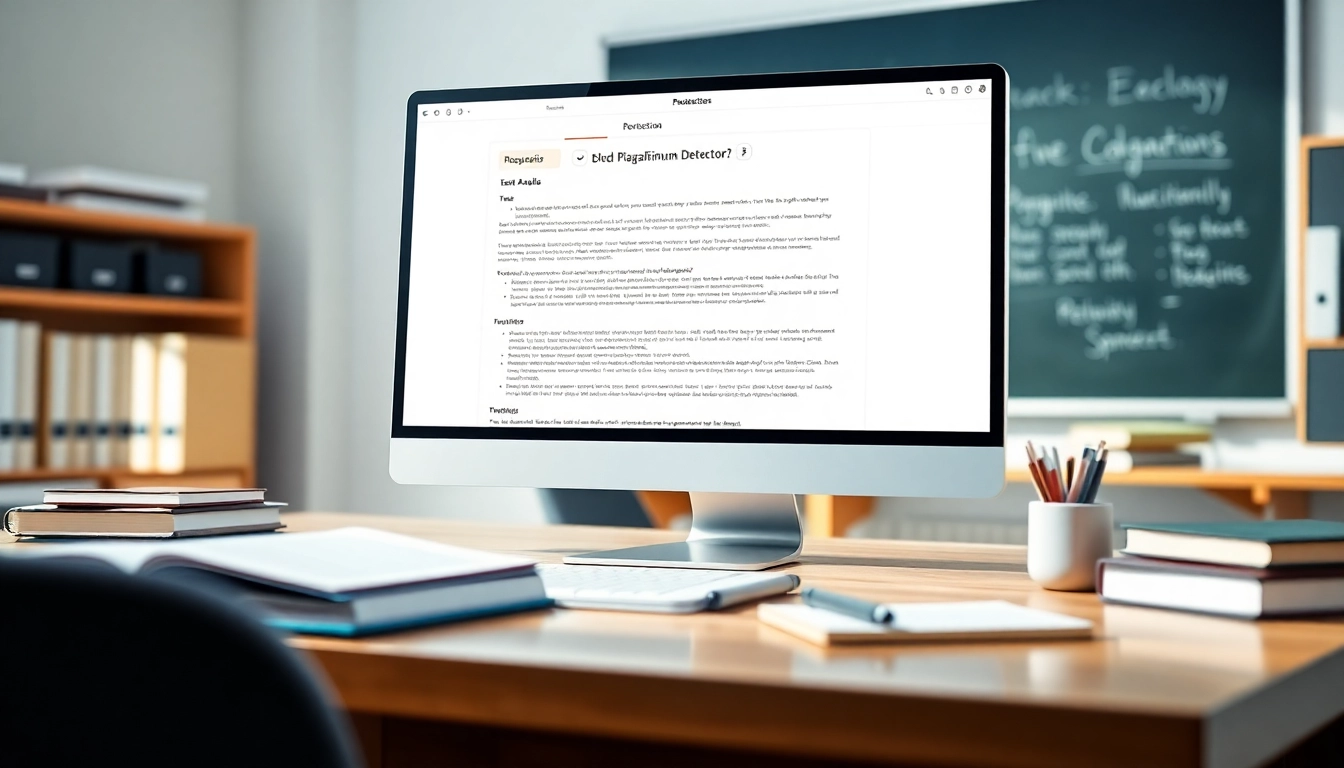
Understanding Plagiarism and Its Impact
Definition of Plagiarism
Plagiarism is the practice of taking someone else’s work, ideas, or intellectual property and passing it off as one’s own without proper acknowledgment. This can include copying text, images, or even ideas from books, articles, websites, or any other creative work. Educational institutions, publishing houses, and various organizations impose serious repercussions on individuals found guilty of plagiarism, from academic penalties to legal actions. The act undermines the very essence of creativity and intellectual honesty, endangering reputation and integrity in academic and professional circles.
Common Misconceptions About Plagiarism
Plagiarism is often misunderstood, leading to confusion about what constitutes plagiarism. Some common misconceptions include:
- “I paraphrased it, so it’s not plagiarism.” While paraphrasing involves rewording someone else’s ideas, failing to cite the original source still counts as plagiarism.
- “If I use quotation marks, I don’t need a citation.” Quotation marks indicate that the text is taken directly from another source, but citations are still necessary to credit the original author.
- “Plagiarism is only a problem in academic settings.” Plagiarism can have serious consequences in the workplace, creative industries, and online content creation.
The Consequences of Plagiarism
Engaging in plagiarism can lead to various consequences depending on the context:
- Academic repercussions: Students may face failing grades, expulsion, or disciplinary action from educational institutions.
- Professional consequences: In the workplace, plagiarism can lead to job termination, loss of credibility, and legal disputes.
- Legal implications: Copyright infringement can result in lawsuits and considerable financial penalties.
- Loss of reputation: Both professional and personal reputations can suffer irreparable damage following plagiarism allegations.
How a Plagiarism Detector Works
Overview of Detection Mechanisms
Plagiarism detectors operate using advanced algorithms and databases to compare submitted text against a wide array of existing content. Here’s how the process generally unfolds:
- Text submission: Users upload or paste their text into the plagiarism detection tool.
- Database comparison: The tool scans the uploaded content against a vast database that includes published works, online articles, and student papers.
- Similarity identification: The detector identifies matching phrases or sentences, quantifying the degree of similarity.
- Report generation: Finally, the tool compiles a report detailing the extent of plagiarism detected, including links to the original sources.
Key Features to Look For in a Detector
When selecting a plagiarism detection tool, consider the following key features:
- Comprehensive database: A robust database ensures that the detector can recognize both common and obscure sources.
- Real-time analysis: Instant feedback allows users to address potential plagiarism issues immediately.
- User-friendly interface: An intuitive design facilitates ease of use across a range of experience levels.
- Diverse file support: Compatibility with various file formats (e.g., DOCX, PDF) broadens usability.
- Detailed reporting: Clear and informative reports help users understand plagiarism issues and improve their writing.
Technology Behind Effective Detection
Underpinning the efficiency of plagiarism detectors are several sophisticated technologies:
- Natural Language Processing (NLP): Enhances understanding of text structure and context, improving the accuracy of detection.
- Machine Learning: Algorithms continuously learn from new data, refining their ability to detect plagiarism over time.
- AI capabilities: Advanced systems can identify paraphrasing and altered text beyond simple matching, recognizing when ideas have been changed while still stealing the underlying concept.
Choosing the Best Plagiarism Detector for Your Needs
Comparison of Free versus Paid Solutions
There are numerous plagiarism detectors on the market, from free tools to paid services. Here’s a comparison to help you determine which service might best fit your needs:
Free Detectors
Free plagiarism detectors can provide basic functionality and may work well for casual users or students:
- Pros: Cost-effective; easy to access; often user-friendly.
- Cons: Limited features; less comprehensive databases; advertisements may disrupt usage.
Paid Detectors
Paid alternatives typically offer enhanced accuracy and extensive features, making them suitable for professionals or institutions:
- Pros: Access to extensive databases; advanced features including AI detection; detailed reporting.
- Cons: Generally higher costs; may require a subscription for ongoing usage.
Must-have Features for Students
Students require specific capabilities from plagiarism detectors to support their academic success:
- User-friendliness: With varying levels of technical expertise, students benefit from intuitive interfaces.
- Feedback and suggestions: Feature that offers improvement tips based on detected plagiarism.
- Affordability: As many students face budget constraints, cost-effective solutions are paramount.
- Compatibility with citation formats: Tools should help understand proper citations to prevent future plagiarism.
User Reviews and Recommendations
User reviews can provide insight into the effectiveness and reliability of different plagiarism detectors. Platforms like plagiarism detector forums and technology blogs offer valuable user feedback. Here are key factors often mentioned in reviews:
- Accuracy: Users note the reliability of results, indicating high success rates in identifying unoriginal work.
- Support: Good customer service is a common theme among recommended tools, helping users troubleshoot effectively.
- Usability: Seamless integration into writing processes is vital, and tools praised for these qualities often receive higher ratings.
Best Practices for Using a Plagiarism Detector
Integrating the Detector into Your Workflow
To maximize the efficiency of a plagiarism detector, it’s beneficial to integrate the tool into your writing and research workflow:
- Initial checks: Run a plagiarism check early in the writing process to ensure originality.
- Iterative checks: Frequently check as you revise to catch issues before final submission.
- Utilize feedback: Analyze reports to understand common pitfalls and improve writing habits.
Interpreting the Results Effectively
Receiving a plagiarism report isn’t enough; understanding the results is crucial:
- Review similarity scores: Identify high percentages and focus on them to address potential issues.
- Evaluate matched sources: Check the cited sources to gauge the originality of your content concerning existing literature.
- Actionable steps: Make a plan to rewrite problematic sections and add appropriate citations as needed.
Using Reports to Improve Writing Skills
Plagiarism detection tools can be valuable teaching aids. Here’s how:
- Highlight weaknesses: Use reports to spot recurring problems in citations or paraphrasing.
- Educational insights: Learn proper attribution practices from examples highlighted within the reports.
- Develop originality: Reflect on patterns, and actively practice writing in a manner that fosters original thought.
The Future of Plagiarism Detection Technology
Emerging Trends in Academic Integrity Tools
The landscape of plagiarism detection is continually evolving. Emerging trends include:
- AI-driven detection: Advances in AI technology enable more sophisticated identification of nuanced plagiarism.
- Integration with learning management systems (LMS): This offers seamless checking within educational resources.
- Real-time collaboration tools: These allow for simultaneous checks during group projects, promoting academic integrity.
The Role of AI in Plagiarism Detection
AI technologies are reshaping how plagiarism detection tools operate:
- Contextual analysis: AI understands the context of writing, detecting potential plagiarism that traditional methods may overlook.
- Adaptive learning: Systems learn from user behavior, improving detection capabilities over time.
- Data-driven insights: Analysis of user results can inform strategies for improving overall writing quality.
Preparing for Future Challenges in Education
As more sophisticated writing technologies arise, the need for effective plagiarism detection will only amplify:
- Continuous updates: Detector systems must evolve to handle AI-generated content and changing writing styles.
- Collaboration between educators and tech firms: Partnerships can lead to more effective detection tools tailored to academic needs.
- Broader adoption: Encouraging the use of plagiarism detection tools will foster a culture of academic integrity.








